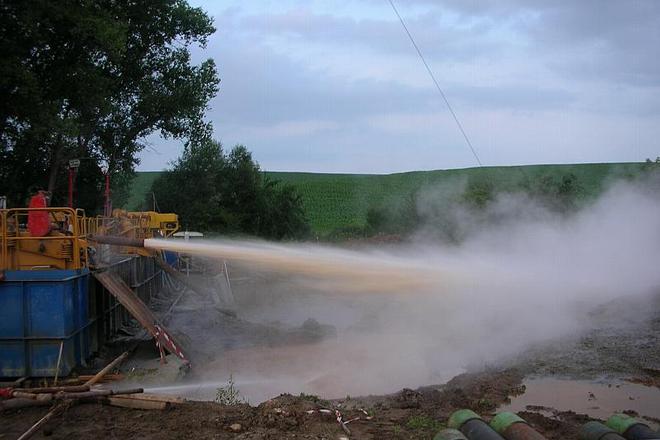SUCH IS THE potential of Slovakia’s geothermal resources that the country could rank among the leaders in Europe - like Italy, Iceland, France and Germany - by using it as a source of energy.
So far, geothermal water in Slovakia is still used mainly for recreation, tourism purposes, and aquaparks, though these use only a small part of the country’s geothermal resources. There is so far only one project (in Galanta, in southern Slovakia) which uses geothermal energy for heating apartments on a large scale. However, there are plans to heat part of Slovakia’s second city, Košice, using geothermal water. If these are carried out in full, it would represent one of the largest such projects in Europe.
“Slovakia has good prerequisites for the development of geothermal energy use,” said Martin Šujan, from Equis, a geological survey firm.
The country has geothermal water resources of a relatively high temperature at technically accessible depths, he added. In a majority of cases these are low to moderate temperature thermal water resources, up to 140 degrees Celsius, according to Šujan.
“However, in general, we can hardly talk about using geothermal energy in Slovakia at all,” said Šujan. If it is used, it is mainly for sports and recreation; using it for energy purposes is very rare, he added.
A geological survey precedes the drilling of wells to access thermal waters – a process which can be extremely demanding and carries a relatively high risk that the well, which typically costs several tens of millions of crowns, will turn out to be dry.
“Investors may have money but they are not always willing to accept such a risk,” he said.
However, he added that in Slovakia there are already several geothermal wells which have been drilled and prepared for use, but are not being employed. Šujan suggested that the reason for this may be the high initial investments needed by geothermal energy projects.
In 1992 Slovgeoterm was established to focus on geothermal energy projects. Its main shareholders are Slovakia’s dominant gas distributor SPP, ENEX of Iceland, and NEFCO Helsinki. In 1996 it launched a geothermal heating plant project in Galanta, in cooperation with the Icelandic company Fjarhitun. The plant is now operated by Galantaterm.
Slovgeoterm is also behind the project which aims to use geothermal energy to heat some of Košice’s apartments.
Oto Halás, a project manager for Slovgeoterm, said that conditions in Slovakia are suitable to allow geothermal energy to be used to heat buildings and provide the hot water used in centralised heating supply systems.
“In selected locations, where high temperature geothermal water is accessible, it is also possible to produce electricity,” he added.
He agreed that Slovakia is currently using only a small portion of its total potential geothermal resources. However, given the European trend towards greater use of renewable energy sources, there is increasing interest in – and a growing number of projects aimed at exploiting - geothermal energy, he added.
Geothermal projects are very investment-heavy and have a longer period of return on investment, which is one of the main obstacles to faster growth in the use of this type of energy, Halás said.
“Towns which are interested in heating using geothermal energy very often don’t have sufficient financial means,” he said.
On the other hand, these projects have long durability and thus, from the long-term point of view, they are very advantageous, Halás added.
“In the past, private investors searched for projects with significantly shorter periods of return on investment. However, today the situation is changing and the interest of private investors in geothermal projects is growing,” he told The Slovak Spectator.
Galantaterm produces 85,000 gigajoules (GJ) of heat out annually, of which more than 90 percent is supplied by geothermal energy. It supplies heat to more than 1,300 apartments and a hospital.
In the Galanta project, two geothermal wells, each 2,100 metres deep, are the main source of heating. Together they supply geothermal water at a temperature of 77 to 78 degrees Celsius with a flow rate of 34 litres per second. There are also four gas boilers installed, but these are used only during periods of peak demand and as a back-up heat source.
In 2008 the price of heat supplied by Galantaterm was Sk419.8 per gigajoule, excluding VAT, while one gigajoule of heat produced by conventional sources in Galanta in the same year cost Sk540.3, excluding VAT, according to Halás.
The existence of an important geothermal water reservoir in the Košice basin in eastern Slovakia was discovered some time ago, during hydrocarbon exploration work. The area has the largest geothermal water potential in Slovakia, Halás said.
There are currently three completed geothermal wells near Košice. The project to use geothermal energy to heat apartments in the city assumes 8 to 10 wells. The total heating output of this geothermal source should be approximately 100 thermal megawatts, and annually it should be possible to supply 2,100 terajoules of geothermal heat.
“Currently, the land needed to complete the project has been purchased and all the necessary construction licences have been issued,” Halás told The Slovak Spectator. “The project is thus ready to be carried out.”
The investment costs of the Košice project are estimated to be €55 million. The return on investment period is calculated to be 5 to 8 years, according to Halás.
“So far, the main barrier to the project is the fact that the main buyer of the geothermal heat, TEKO [Heating Company Košice] has so far not confirmed the price and the volume which it would purchase,” Halás said.


 The high start–up cost of drilling wells may discourage investment in geothermal energy. (source: Courtesy of Equis)
The high start–up cost of drilling wells may discourage investment in geothermal energy. (source: Courtesy of Equis)